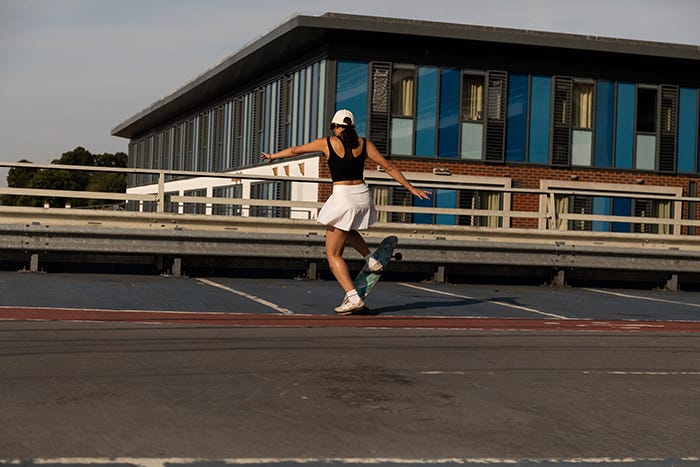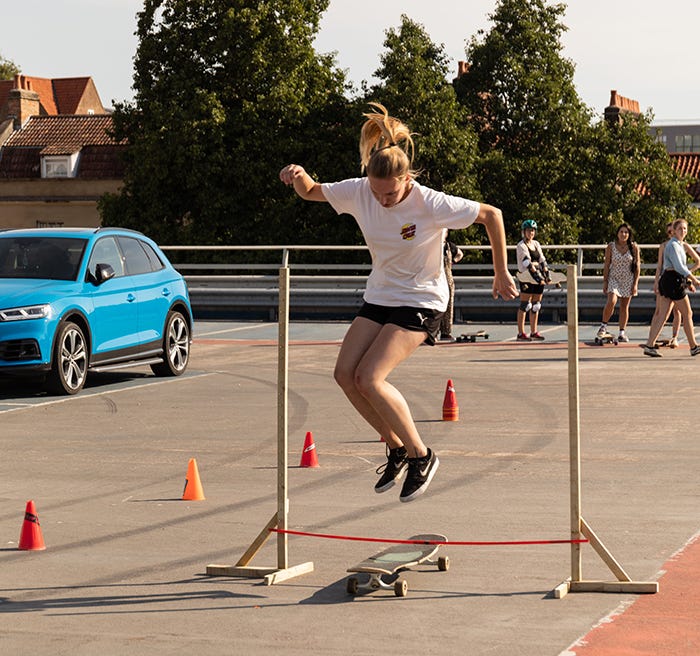10 Longboard Beginner Tricks
Coleman Slide
One trick is to learn how to slide. This is a commonly used technique to quickly stop. Sliding involves pulling your board out so that the wheels move freely without gripping the pavement. Any longboard slide is fine. A popular one and great for beginners is the Coleman slide.
This slide technique was developed by the legendary Cliff Coleman in the 1970’s. He is still doing slides these days. The Coleman slide is considered one of the best slides for beginner longboarders.
First thing you need to think about is safety. Going downhill can be dangerous. Wear a helmet and guards! Very important. For sliding you will need sliding gloves. These are gloves with pucks in the palm of your hand. Sliding gloves allow you to put your hands on the ground at speed without hurting yourself while sliding. They act as brakes.
Start small, skate a large flat area like an empty car park. Work your way up to a semi steep hill remember it has to have room to slide 15 - 30 feet.
Tips : You need to go fast enough to slide and need to leave enough space so you can slide 180 degrees. Don't reach too far back with your hand, you will fall backwards onto your butt.
Downhill Tuck
To those who are completely unfamiliar with the entire concept of the downhill tuck, also called the speed tuck,it is a positioning of the body and ligaments in order to achieve minimum wind resistance. The downhill tuck is commonly used during downhill racing, but can also be used, to an extent, during freeride and other forms of riding.
Patrick Switzer does a perfect downhill tuck, Patrick Switzer, also known as “P-Swiss” is recognized as a world champion of downhill longboarding.
At first, speed tucking can be uncomfortable and full of air pockets, but practice makes perfect. You’re going to notice that tucking is more difficult while moving, so I advise starting on a slower run. Not only is it difficult to maintain stability while learning to tuck, but your legs are going to burn pretty badly.

Heelside Stand up 180 Slide
Before trying this slide, you should already know how to carve and how to slow down. It’s easy to learn at very slow speeds, and it’ll give you a feel for controlling your wheels without putting a hand on the road. Once you get faster with this, you’ll find that this is one of the easiest slides to do at high speeds, partly because it’s very easy to run out of it. If you’re going too fast to run, you can just bail to your knees and slide it out, remember to wear knee pads if you do this!
To start your front leg should be at the same distance from the trucks as your back leg, and positioned at a slight angle.The closer your feet are to each other, the more stable and longer the slide. Speed up, crouching down slightly, begin turning your torso and pushing the board forward with your back leg, all while keeping your weight over the centre of the board. Turn your shoulders to switch, your board will follow on its own.
Manual
A manual is a freestyle longboarding trick where you shift your weight to the back or front of your board in order to lift the front or back wheels into the air without the tail or nose of the board touching the ground.
When learning a manual it's best to learn in an open area with level ground and no obstructions like a carpark. When doing a manual, balancing is essential. To start a manual, begin putting weight on your back foot slowly and gently lean slightly forward with your upper body while you do this. The increased pressure on your rear foot should raise the skateboard’s front wheels. continue doing this for as long as possible. Focus on your natural balance. Gently shift your weight to your front foot from your rear foot. Restore your upper body’s natural upright posture as you do this.
180 Pirouette
A 180 pirouette is a half spin around your own axis performed on one foot only while moving forward. Advice to stop your back foot from landing on the floor instead of landing on the board is to practise if you want it to be a fluid movement.
To start, bring your front foot to the centre of your board, drop your body down and spring up throwing your arms across your body. Good advice is to learn to step around your board and get comfortable doing that.
Peter Pan
The Peter Pan is a longboard dancing trick where you walk criss-cross with feet parallel in the middle of the deck.
Begin cross‑stepping with your leading leg, step your back foot in front of and parallel to your front foot. Make sure you’re putting your toe down first (followed by your heel). This gives you the flexibility to smoothly release the foot that was previously on the board. (Repeat steps 2+3 if you want.) When your back leg is crossed in front, step your front foot back at an angle into your original stance. Adjust your back foot to a big wide stance for stability.
Ghostride
A Ghostride is a trick when you jump off the board while moving and jump back on again.
To start, bring your front leg back to the centre of the board, Back foot goes around the front leg and off the board. At this point you have to use your front leg to jump off the board and simultaneously push it forward, so that it continues riding alongside you. Then just jump back onto the board.
Pivot
In order to execute this trick you will need to weight the nose of your board, and utilise your shoulders and upper body to engage the pivot.
You will find that the amount of weight on the nose will determine how much your wheels drag across the floor. The more weight you put on your nose, the less controlled, but easy it will be to move the board, I call this the “whipping” motion of the pivot
To start, begin with bringing your front foot down on the nose, back foot in the centre. Then start turning your frame, shift your weight to your front foot, raising your rear wheels off the ground. At the end of the movement, transfer some of your weight to your new leading leg, and ride off in switch.

Tiger Claw
Tiger claw is when a rider jumps off the board, spins it with hand to 360° in front of him and jumps back on the board.
To start with you need to move your front leg to the side, slightly turning your body to frontside, while you do this you need to pop your board with your back foot this way your board will fly up already rotating behind your back. Catch the board under the trucks with your front hand, begin spinning the board with your whole hand, and complete it by bringing it underneath you with a wrist motion. To finish Jump onto the board right when it lands on the ground.
Hippie jump
A hippie jump is when you jump over an obstacle while the board roles under it and ideally the skater lands on the board on the other side of the obstacle.
To begin, Shift your weight to the back of your board as you approach the obstacle, this makes it easier to clear it and land back on your board safely. When you start to jump, jump straight up, the timing can be tricky but will come with practice. Land centred in your normal stance. Your body will naturally want to land with your feet off the sides of the board because you're scared. You can force yourself to get over this fear by jumping on your board without an obstacle.


